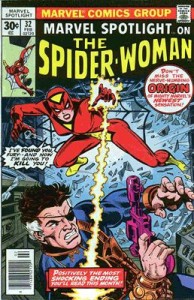 I’d read about half of these adventures before. I still vividly recall the announcement on the Marvel Comic’s monthly “Bullpen Bulletins” page: Marvel was creating two new super-heroines to star in their own series. Now I love super-heroines, and did, perversely, when I was in elementary school and wasn’t supposed to. You know those boys who didn’t buy female action figures? Yeah, I wasn’t one of them.
I’d read about half of these adventures before. I still vividly recall the announcement on the Marvel Comic’s monthly “Bullpen Bulletins” page: Marvel was creating two new super-heroines to star in their own series. Now I love super-heroines, and did, perversely, when I was in elementary school and wasn’t supposed to. You know those boys who didn’t buy female action figures? Yeah, I wasn’t one of them.
The new characters weren’t exactly original. Ms. Marvel (who premiered in her own title cover-dated January, 1977) was a hot-pants-wearing version of Captain Marvel, with an oh-so-Seventies scarf. And Spider-Woman? She wasn’t pictured in the announcement (Ms. Marvel’s cover was), but she sounded like another knockoff. Still, I’ve never said a word against Supergirl, Batgirl, Mary Marvel or Hawkwoman, so… I of course picked up both premiere issues. Spider-Woman appeared a month after Ms. Marvel in Marvel Spotlight #32. That’s where this collection picks up.
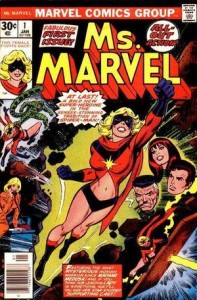 What had prompted Marvel to introduce female versions (at least in name) of some of their heavy hitters? I think they claimed a commitment to gender equality. It was more likely a fear of trademark infringement. In fact, in 1978, Stan Lee said as much about Spider-Woman, in a speech at James Madison University.
What had prompted Marvel to introduce female versions (at least in name) of some of their heavy hitters? I think they claimed a commitment to gender equality. It was more likely a fear of trademark infringement. In fact, in 1978, Stan Lee said as much about Spider-Woman, in a speech at James Madison University.
Stan claimed he just “suddenly realized” that some other company could do a Spider-Woman book and he wouldn’t have a claim on the name.
This conflicts with the editor’s claim (presumably Roger Stern) in the letters page of Spider-Woman #14 that it was an actual claim-jumper who caused them to quickly create the character. A letter-writer had advanced the story (citing artist / fanzine publisher Fred Hembeck as the source) that a movie producer had attempted to release a feature film with a character named Spider-Woman.
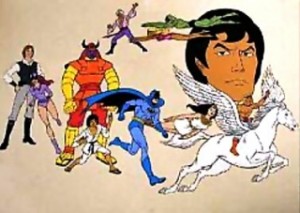 Stern contested that the rival “Spider-Woman” was developed for TV, not film, and that she appeared (with a different name) on a show opposite Marvel’s own Fantastic Four cartoon in the 1978-79 Saturday Morning lineup. Opposite FF at the time was Filmation’s Tarzan and the Super Seven, a showcase of different Filmation series. It included The New Adventures of Batman, The Freedom Force (with Isis, Super-Samurai, Sinbad, Merlin and Hercules), and Jason of Star Command — all properties which had existed in previous seasons — and new entries Manta and Moray, Superstretch & Microwoman, and… Webwoman.
Stern contested that the rival “Spider-Woman” was developed for TV, not film, and that she appeared (with a different name) on a show opposite Marvel’s own Fantastic Four cartoon in the 1978-79 Saturday Morning lineup. Opposite FF at the time was Filmation’s Tarzan and the Super Seven, a showcase of different Filmation series. It included The New Adventures of Batman, The Freedom Force (with Isis, Super-Samurai, Sinbad, Merlin and Hercules), and Jason of Star Command — all properties which had existed in previous seasons — and new entries Manta and Moray, Superstretch & Microwoman, and… Webwoman.
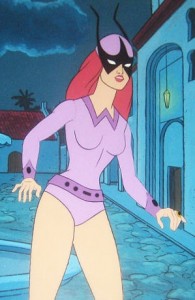 So the claim-jumper was Filmation. Stan Lee is well known for his selective memory, but most likely he just didn’t want to give Filmation any free publicity, since they were so embroiled in the Distinguished Competition’s characters, Shazam and Isis, and had produced all the 1960s adventures of the Justice League.Note: I was very proud of detective work in tracking down this information, based on Stern’s cryptic comments. But last night my son told me that the whole Webwoman connection is already common knowledge, courtesy of the excellent Comic Book Urban Legends Revealed website. Oh well!
So the claim-jumper was Filmation. Stan Lee is well known for his selective memory, but most likely he just didn’t want to give Filmation any free publicity, since they were so embroiled in the Distinguished Competition’s characters, Shazam and Isis, and had produced all the 1960s adventures of the Justice League.Note: I was very proud of detective work in tracking down this information, based on Stern’s cryptic comments. But last night my son told me that the whole Webwoman connection is already common knowledge, courtesy of the excellent Comic Book Urban Legends Revealed website. Oh well!
But back to Arachne the Spider-Woman…
Yes, “Arachne” was her name in that Marvel Spotlight appearance, written by Archie Goodwin, drawn by Sal Buscema and Jim Mooney (based on designs by Marie Severin). Sal Buscema was 1970s Marvel to me. He didn’t have the photo-realism of Adams, the fluidity of Byrne, or the slick awesomeness of his brother John, but his characters had expression. You felt with them. Witness the horror on Arachne’s face when she learns her true origins, and you see what I mean.
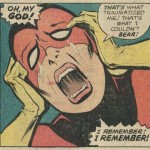 Jim Mooney was no stranger to super-heroines, having been principal artist on Supergirl’s strip for many years, as well as drawing not a few adventures of the Legion of Super-Heroes.
Jim Mooney was no stranger to super-heroines, having been principal artist on Supergirl’s strip for many years, as well as drawing not a few adventures of the Legion of Super-Heroes.
Arachne was a curly-topped Brunette working for the terrorist group HYDRA. She’d been rescued by HYDRA ‘s Count Vermis after the locals in a Balkan village had turned on her. She’d displayed her bioelectric shock powers, accidentally killing a young man she loved. The villagers had wanted her dead. Vermis gave her a home and a costume, and duped her into believing a young HYDRA agent was in love with her. Then he’d sent her to kill Nick Fury of SHIELD. (If you don’t know who he is, I simply can’t help you. Please see a doctor. And at least a couple of movies a year.)
Fury showed her the error of her ways, and Count Vermis revealed her origins: She was the product of a scientist-turned god named the High Evolutionary. He had this habit of creating “New Men,” — sentients evolved from lower animals. He’d evolved Arachne from a lower animal… guess which one?
So… lemme stop a minute here and comment on something. Much later, in her own series, Mark Gruenwald established that Spider-Woman was nursed by the cow woman Bova, and then turned loose among villagers who almost killed her because she was different. Go back in my blog about a month, and you’ll read about Wanda and Pietro, nursed by Bova, and then turned loose among… villagers who… almost killed them because…
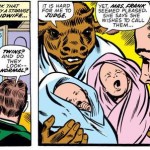 So is it that the villagers are stupid and xenophobic? Or is it just that Bova is one sick, sadistic cow? I mean, how could she not see that coming in either case? And she did it twice! (Three times, really, counting Wanda and Pietro.)
So is it that the villagers are stupid and xenophobic? Or is it just that Bova is one sick, sadistic cow? I mean, how could she not see that coming in either case? And she did it twice! (Three times, really, counting Wanda and Pietro.)
Anyway, I really liked evolved-spider origin, then and now. Arachne was so alien, so totally removed from the mundane experiences of everyday life. She was also established as someone who people — women especially — instinctively disliked and feared. What a tragic affliction for a young woman to suffer!
Another note: The origin she was first given was, in fact, planned by Len Wein and/or Chris Claremont to be Wolverine’s origin. Again courtesy of Comic Book Urban Legends.
Alas, Goodwin and Sal Buscema did not stay with her. Marv Wolfman would author her next dozen appearances, with Carmine Infantino pencilling the first 18-odd issues of her solo title.
Wolfman’s Spider-Woman was still a mystery. Searching for her identity in the pages of Marvel Two-In-One, she met Modred the Mystic, a holdover from Camelot, who revealed her real origin. She was Jessica Drew, daughter of John Drew, once partner to the man who became the High Evolutionary. Little Jessica was exposed to radiation, and her father attempted to derive a serum from spider’s blood to save her. Then her mother died of grief or shock or something convenient and Victorian (perhaps it was a severe chill), and her father just vanished. It was left to the High Evolutionary to save Jessica by using his powers of evolution.
Now, for me, that origin was less awe-inspiring, and I frankly liked the name “Arachne” better than “Jessica Drew,” which sounds like Nancy’s cousin. (Much as I — like any other 1970s SF fan — love the name “Jessica,” courtesy of Logan’s Run.) And the sense of mystery wasn’t aided by Wolfman’s revelation that Jessica’s father had left his divine retreat to work a day job in the military industrial complex. Quite the comedown.
Still and all, with Carmine Infantino’s pencils behind them, Wolfman’s eight issues of Spider-Woman are downright lyrical at times. She faces mystical, twilight-dwelling opponents like the Brothers Grimm, Morgan Le Fay and Excalibur, and the Hangman. Famed for his work on the Silver-Age Flash, Infantino, the onetime publisher of DC Comics, at his best, draws everyone to look like a character out of Norse myth, and he’s great at chiaroscuro–the pinpoint of light in darkness effect–which suits Spider-Woman so well. His inkers changed frequently, though, which hurt. Tony DeZuniga seemed to have the best touch, and Al Gordon’s inking started perhaps a bit rough, but developed a subtlety that worked.
Having solved all Jessica’s mysteries and given her a SHIELD-agent boyfriend and (yet another) Camelot-era wizard as a mentor, Wolfman ended his run with an issue that contained two stories he’d apparently been saving since his teens, as they were obviously shorts composed for books like House of Secrets over at DC. “The Man Who Could Not Die,” and “The Suit” barely feature Spider-Woman, and, when she’s there, she plays a part anyone else could have played.
Mark Gruenwald took over writing, and, with Infantino, created such haunting villains as the Needle and Gypsy Moth, not to mention bringing a sad and somber end to the tale of Mrs. Dolly and her sons, the Brothers Grimm. He toyed with a romance for her with the Shroud, a Batman knockoff from Super-Villain Teamup, and he pitted her against Nekra, one of the creepier supernatural villains at Marvel. He created the Waxman, a villain so creepy that even Gruenwald said he couldn’t sleep after writing him. He paired her twice with Jack Russell, the Werewolf by Night, and even hinted that the two might become an item…
Then, Infantino left, Gruenwald wrote one uninspired encounter with Spider-Man, and he, likewise, departed.
Aside from the end, it doesn’t sound too bad, right? Except that the signs are there almost from the beginning of Gruenwald’s stint that the character is floundering and he doesn’t know what the hell to do with her. He Steve-Trevors her boyfriend, Jerry Hunt, Agent of SHIELD, by making him sulky over the fact that his girlfriend is superhuman and keeps bailing him out of trouble. The petulant and whiny Hunt is rejected by readers and then written out, and there’s a whiff of whatever you call the opposite of misogyny in Jessica’s growing resentment of him. Then there’s the fact that he puts Jessica in literally HOURS of therapy a day, and has her working off her debt to the clinic as a receptionist. She starts on a treatment so that her pheromones won’t make people hate her. Then she’s fired, evicted, and turns to theft.
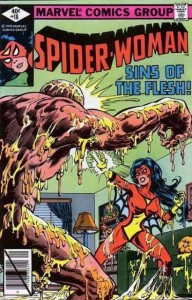 Gruenwald seemed to be deconstructing the character. Now I’m not saying that change didn’t need to come. Wolfman had finished his arc leaving little foundation for the future. But Gruenwald didn’t seem to know where to take her, and instead fell back on 1970s California cliches. Even the creepiness of the Waxman is weakened by the fact that she meets him at a disco as a girlishly pretty muscle dude who picks her up with the line, “C’mon, Jessica! Let’s Hustle!” Ick. That made my skin crawl more than actually seeing his skin crawl did.
Gruenwald seemed to be deconstructing the character. Now I’m not saying that change didn’t need to come. Wolfman had finished his arc leaving little foundation for the future. But Gruenwald didn’t seem to know where to take her, and instead fell back on 1970s California cliches. Even the creepiness of the Waxman is weakened by the fact that she meets him at a disco as a girlishly pretty muscle dude who picks her up with the line, “C’mon, Jessica! Let’s Hustle!” Ick. That made my skin crawl more than actually seeing his skin crawl did.
I realize that these issues were Gruenwald’s first writing assignments in comics. I also know that he’s the editor who fired Roger Stern (because Stern refused to write the editor’s proposed first stab at “Avengers Disassmebled.” And rightly so.) And Steve Englehart, for my money the best of the Avengers writers, left West Coast Avengers with a sour taste in his mouth while Gruenwald was editing that. Maybe not Gruenwald’s fault, but… I get the sense the guy, story-development wise, batted somewhere around .250.
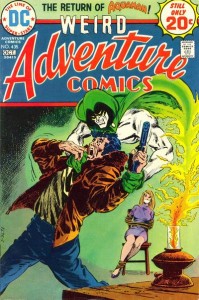 The final five issues included in this volume were written by Michael Fleisher. Now, in the 1970s, Fleisher had broken new ground with his daring and different interpretation of the Spectre in Adventure Comics. This Spectre killed with abandon and deliver justice on a cosmic scale. It was unlike anything seen before in superhero comics. And all this was drawn by the amazing Jim Aparo. Alas, Fleisher did not bring that magic to Spider-Woman. Instead he turned her into a wise-cracking, grinning bounty hunter with an all-new (and not interesting) supporting cast.
The final five issues included in this volume were written by Michael Fleisher. Now, in the 1970s, Fleisher had broken new ground with his daring and different interpretation of the Spectre in Adventure Comics. This Spectre killed with abandon and deliver justice on a cosmic scale. It was unlike anything seen before in superhero comics. And all this was drawn by the amazing Jim Aparo. Alas, Fleisher did not bring that magic to Spider-Woman. Instead he turned her into a wise-cracking, grinning bounty hunter with an all-new (and not interesting) supporting cast.
These stories have a simplistic, Golden Age feel to them. That isn’t necessarily bad, it’s just… not where this character seemed to want to go. Worst of all, Jessica’s venom blasts can now only be used once an hour, a gimmick so obvious that you can see the gears of the storytelling machine moving. At one point, a villain confronts her with six henchmen. She blasts the first one and then is taken down by the other five because, of course, that’s all the super power she’s got. And the villain credits his victory to the fact that he knew she’d be here and brought reinforcements. You don’t think it, like, had anything to do with the fact that she was suddenly too stupid to use strategy and not waste her one shot?
Fleisher wrote seven more issues not included in this volume. They may have gotten better. I think I own a few of them loose, but I don’t remember. I know I stopped reading the book back then because it no longer interested me. I don’t even know if the question of what happened to her venom blasts was ever answered. I assume the meds she was taking to make her “likable” was hampering them. I do know that, after Gruenwald left, the issue of Jessica repelling strangers was not raised again.
Spider-Woman is now once again an extremely popular and important figure in the Marvel Universe. Brian Michael Bendis brought her back, after a years-long absence, to be an Avenger. This volume gives a glimpse into her early origins, tied inextricably into other threads of the Marvel Universe. It shows some of the real promise of her as a character, and it shows how creators don’t always know how to make promises come true. But the good thing about comics is that, if you don’t care for the current creative team’s take on a character, you know there’ll be a new team soon enough.
